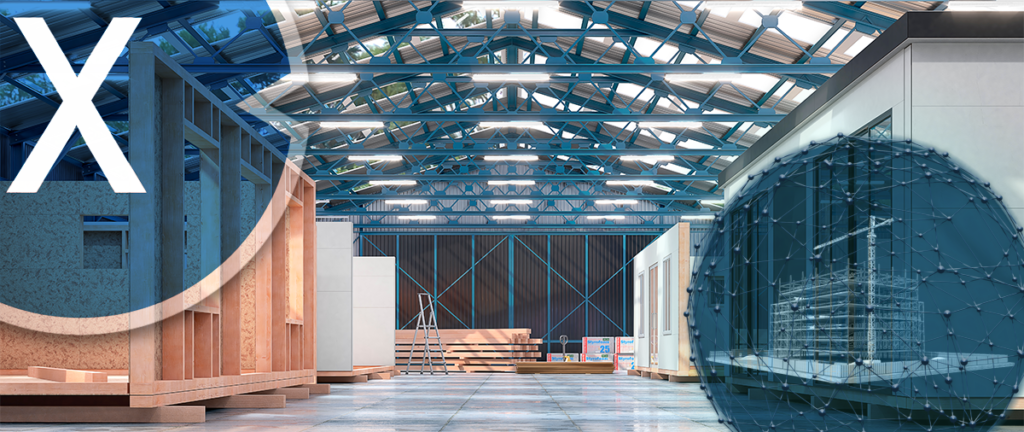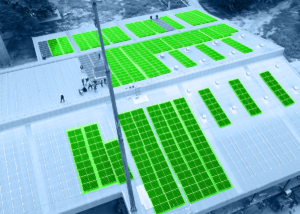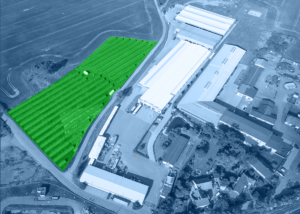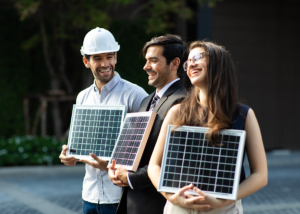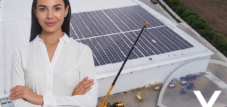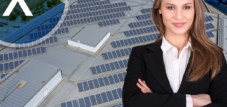Efficient construction with solar: How a construction company saves time and money with photovoltaics, cold halls, dry halls and heat pumps
Language selection 📢
Published on: July 13, 2023 / Update from: July 13, 2023 - Author: Konrad Wolfenstein
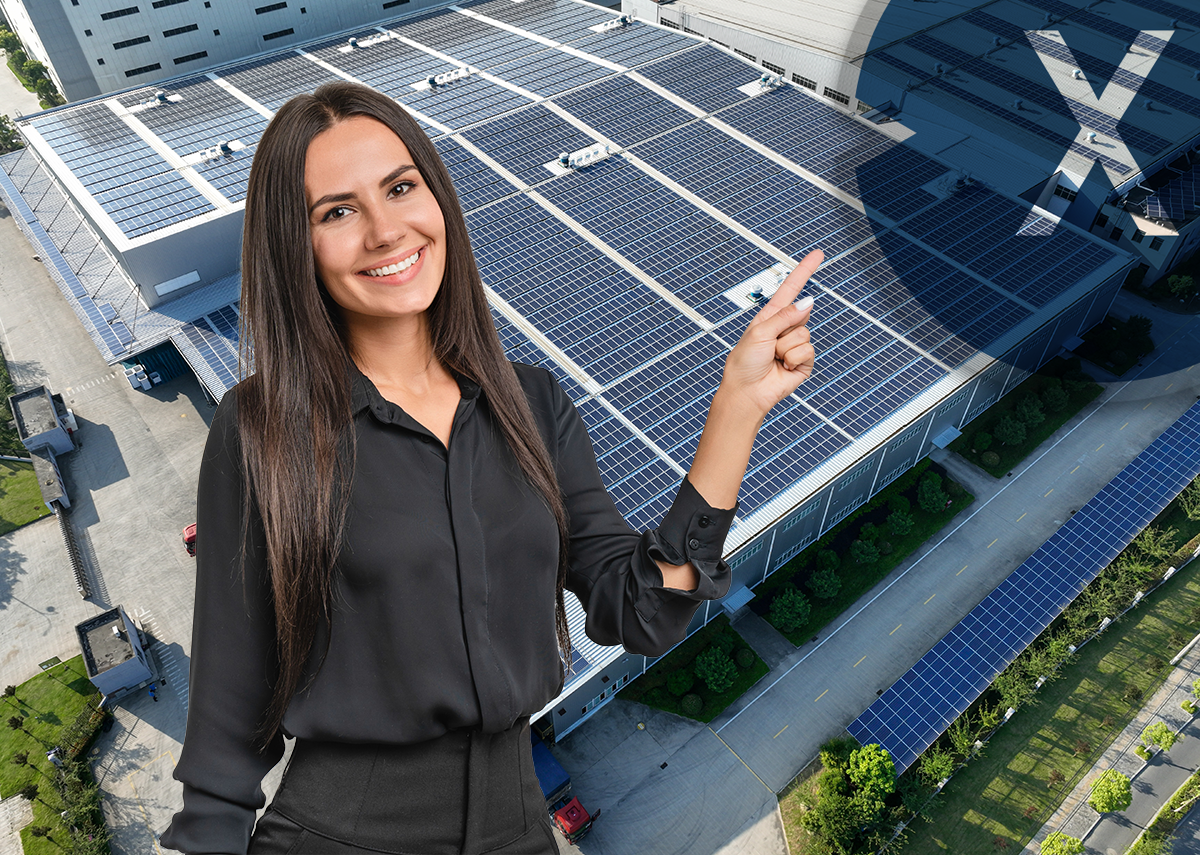
How a construction company saves time and money with photovoltaics, cold halls, drying halls and heat pumps - Image: Xpert.Digital
Save costs and promote sustainability: Construction companies rely on heat pumps and photovoltaic modules for efficient construction
Efficient construction is crucial today to meet sustainability and cost-effectiveness requirements. Some construction companies have already realized that they need to specialize in this area in order to meet the needs of their customers. They rely on innovative technologies such as heat pumps and photovoltaic modules (or solar systems) to make their cold halls and drying halls energetically efficient.
The use of heat pumps in cold halls and drying halls is an example of such innovative technology. Heat pumps use ambient heat to heat or cool buildings. They work more efficiently than traditional heating and cooling systems and can significantly reduce energy consumption. By using heat pumps in cold halls and drying halls, construction companies can not only reduce their ecological footprint, but also reduce their energy costs.
Another important component of efficient construction are photovoltaic modules or solar systems. This technology converts sunlight into electrical energy that can be used directly on site. Construction companies can install these modules on the roofs of their cold halls and drying halls to meet their energy needs. The solar energy obtained can be used for lighting, machines and devices or for air conditioning in the halls. By using solar modules, construction companies can not only reduce their energy costs, but also make their contribution to climate protection as they use clean energy from renewable sources.
Efficient construction with heat pumps and solar modules for cold halls and dry halls offers a number of advantages. On the one hand, by using these technologies, construction companies can reduce their energy consumption and their dependence on conventional energy sources. This leads to cost savings and a smaller environmental footprint. On the other hand, these technologies enable greater flexibility in the planning and use of the halls. The energy generation through the photovoltaic modules and the energy-efficient heating or cooling through the heat pumps create a pleasant working environment and contribute to increasing productivity.
Furthermore, it is important to mention that these innovative technologies are not only suitable for new construction projects, but also for retrofitting existing halls. Construction companies can equip existing cold halls and drying halls with heat pumps and photovoltaic modules to improve their energy efficiency. This enables construction companies to offer their customers sustainable and cost-effective solutions without having to build completely new buildings.
Efficient construction with heat pumps and photovoltaic modules for cold halls and drying halls is not only an environmentally friendly solution, but also makes economic sense. By using these technologies, construction companies can reduce their energy costs and increase their long-term profitability. At the same time, they contribute to climate protection and position themselves as pioneers in the construction industry.
➡️ Efficient construction with heat pumps and solar modules for cold halls and drying halls is a future-oriented strategy to meet the requirements for sustainability and cost efficiency. The construction companies that use these technologies can strengthen their competitiveness by offering their customers sustainable and energy-efficient solutions. At the same time, they make an important contribution to environmental protection and contribute to the long-term development of the construction industry.
📣 Energy-related renovation and new construction, consulting, planning and implementation for industry, retail and municipalities
Our experienced team will support you in optimizing your buildings to reduce energy consumption and promote sustainable energy use with photovoltaics. We analyze your individual needs and create tailor-made concepts that make sense both economically and ecologically. Regardless of whether it is about the energy-efficient renovation of existing buildings or the construction of new energy-efficient structures, we are at your side. Industrial facilities, retail buildings and municipal facilities can reduce their energy costs and reduce environmental impact while improving the comfort and efficiency of their buildings through our tailored solutions.
👨🏻 👩🏻 👴🏻 👵🏻 Energy-saving renovation and new construction, advice, planning and implementation for private households
We offer comprehensive support for private households in the energy-efficient renovation and construction of new buildings with photovoltaics. Our experienced team is at your side to help you advise, plan and implement your sustainable energy solutions. We analyze your energy consumption, identify savings potential and develop tailor-made concepts to improve your energy efficiency. From improving building insulation to installing energy-efficient windows and doors to installing photovoltaic and solar systems - we accompany you step by step to make your home more energy efficient and environmentally friendly. Trust in our expertise and benefit from the numerous advantages that energy renovation and the use of renewable energies offer you. Together we will create a sustainable future for your home.
Sustainable solutions for the construction industry: Construction companies optimize energy efficiency with cold halls, dry halls and renewable energies
Sustainable construction projects are becoming increasingly important these days, and construction companies play a crucial role in this. They rely on innovative technologies to offer their customers energy-sustainable solutions. An important element are energetic cold halls, which enable construction companies to build efficiently and in an environmentally friendly manner.
Cold halls are specially designed halls used for storing materials and carrying out construction projects under controlled conditions. They are equipped with energy efficient technologies that reduce energy consumption. These include, for example, well-insulated walls and roofs to minimize heat loss, as well as efficient lighting systems based on LED technology. By using such technologies, construction companies can significantly reduce energy consumption in cold halls and thus contribute to the energy efficiency of their construction projects.
Another important component of sustainable construction projects are energy-efficient drying halls. These halls are used to dry materials under controlled conditions to ensure their quality and durability. Construction companies also rely on energy-efficient technologies for drying halls in order to minimize energy consumption. These include, for example, modern drying systems that precisely regulate the moisture of the materials and only use the energy required. By using such energy-efficient technologies, construction companies can reduce resource consumption while ensuring the quality of their construction projects.
An important component of sustainable construction projects is the use of renewable energies. Construction companies install solar modules or solar systems on the flat roofs of the halls to generate clean energy from sunlight. These solar modules convert sunlight into electrical energy, which can either be fed directly into the halls or into the public power grid. The use of solar energy allows construction companies to reduce the need for conventionally generated energy and thus reduce the environmental impact of their construction projects. They can also generate additional income by selling excess electricity.
Another important aspect of sustainable construction projects is the use of heat pumps to heat the halls. Heat pumps use ambient heat to heat buildings and are an energy-efficient alternative to traditional heating systems. By using existing heat from the environment, heat pumps require less electrical energy to generate heat. This not only contributes to energy savings, but also reduces CO2 emissions from construction projects. Construction companies use heat pumps as sustainable and cost-efficient heating solutions in their halls.
➡️ Construction companies use various technologies in sustainable construction projects to ensure energy efficiency and environmental friendliness. The use of energetic cold halls, energy-efficient drying halls, solar modules and solar systems on the flat roofs as well as heat pumps to heat the halls helps to reduce energy consumption and use renewable energies. This allows construction companies to offer their customers efficient and sustainable solutions that make both economic and ecological sense. With their contribution to the energy transition and the reduction of environmental impacts, construction companies make an important contribution to the sustainable development of the construction industry.
Efficient storage and optimal material quality: The difference between cold halls and dry halls
Cold halls and dry halls are two different types of halls that are widely used in the construction industry and fulfill different functions.
Purpose of use
Cold halls are primarily used for storing materials, while drying halls are used to dry materials under controlled conditions. Cold halls provide a protected space in which materials can be protected from the elements such as rain, snow and sun. They enable safe and controlled storage of building materials, tools and other items. Drying halls, on the other hand, are specifically designed to dry materials such as wood, plaster, paint or other building materials under ideal conditions to ensure their quality and durability.
Air conditioning
Cold halls are usually air-conditioned to keep the temperature and humidity at a constant level. This is important to protect the materials from moisture damage and to ensure optimal storage conditions. Drying halls, on the other hand, are often equipped with special drying systems that can control and regulate humidity. Air conditioning in drying halls aims to reduce humidity and optimize drying processes.
Construction method
Cold halls and dry halls can have different design features to suit their specific uses. Cold halls are usually well insulated to minimize heat loss and keep the temperature inside at a constant level. They can be equipped with effective ventilation to promote air circulation and avoid moisture problems. Drying halls, on the other hand, are often equipped with special insulation systems to efficiently regulate moisture and optimize the drying processes. The construction method and choice of materials can vary depending on the requirements and materials.
Furnishing
Cold halls and drying halls can be provided with various facilities and equipment depending on requirements. Cold storage sheds can contain shelves, storage racks or special storage systems to store materials neatly and safely. They may also be equipped with special devices to prevent moisture damage, such as desiccants or dehumidifiers. Drying halls, on the other hand, are equipped with drying systems that enable precise control of humidity. This often includes special ventilation systems, drying chambers or drying cabinets that ensure optimal drying of the materials.
Areas of application
Cold storage sheds are widely used in the construction industry and are used for various purposes, such as storing building materials, tools, machinery or even vehicles. They provide a protected environment for material management and enable better organization of construction projects. Drying halls, on the other hand, are primarily used in the construction industry to dry materials such as wood, plaster or paint under optimal conditions. They are particularly important to ensure the quality of the materials and ensure the durability of the structures.
➡️ Cold halls and dry halls are specialized hall concepts that are tailored to different requirements in the construction industry. While cold halls are primarily used to store materials and provide a controlled environment, drying halls specialize in the efficient drying of materials. Both types of halls play an important role in optimizing work processes and quality assurance in the construction industry.
Cold sheds are widely used in the construction industry and serve an important function in storing materials and carrying out construction projects. They provide a sheltered space that protects from the elements such as rain, snow, sun and moisture. This allows construction companies to store their materials in a controlled environment and protect them from damage. By air conditioning the cold halls, the temperature and humidity can be kept at a constant level in order to protect the materials from moisture damage. This is particularly important to ensure the quality and durability of the materials.
Cold halls also offer the advantage of better organization and accessibility of materials. They can be equipped with shelves, storage racks or special storage systems to store materials neatly and safely. Well-structured storage allows construction companies to save time and work more efficiently because they can quickly and easily access the materials they need. In addition, cold halls can be equipped with special devices to control the humidity in the hall, such as desiccants or dehumidification systems. This helps ensure the materials remain in optimal condition and prevent moisture damage.
Dry halls are another important component of sustainable construction projects. They are used to dry materials such as wood, plaster, paint or other building materials under controlled conditions. By drying materials in a specific environment, construction companies can ensure they are at the correct moisture level before incorporating them into the construction. This contributes to the durability of the structures and reduces the need for repairs or maintenance in the future.
Drying halls usually have special drying systems that enable precise control of humidity. This often includes ventilation systems, drying chambers or drying cabinets that dry the materials in an optimal climate. These systems ensure even drying and prevent moisture buildup that can lead to mold or other damage. By using dry sheds, construction companies can ensure that their building materials have the correct moisture content and meet quality standards.
The differences between cold halls and dry halls mainly lie in their use and equipment. While cold halls are primarily used to store materials and provide a controlled environment, drying halls are specifically designed to dry materials under optimal conditions. Both types of halls are important tools for construction companies to ensure the quality of their construction projects and to work efficiently. By combining cold halls and dry halls, construction companies can optimize their workflows and ensure efficient material management, ultimately leading to high quality and sustainable construction projects.
Plan your solar system for the most common applications conveniently online with our solar system planner!
With our user-friendly solar system planner you can plan your individual solar system online. Whether you need a solar system for your home, your business or for agricultural purposes, our planner offers you the opportunity to take your specific requirements into account and develop a tailor-made solution.
The planning process is simple and intuitive. You simply enter relevant information. Our planner takes this information into account and creates a tailor-made solar system that meets your needs. You can try out different options and configurations to find the optimal solar system for your application.
Additionally, you can save your plan to review later or share with others. Our customer service team is also available to answer your questions and provide support to ensure your solar system is optimally planned.
Use our solar system planner to plan your individual solar system for the most common applications and advance the transition to clean energy. Start now and take an important step towards sustainability and energy independence!

The solar system planner for the most common applications: Plan the solar system online here - Image: Xpert.Digital
More about it here:
From burden to opportunity: avoid CO2 taxes and benefit
Since 2021, the consumption of fossil fuels has been subject to CO2 taxes. These taxes are intended to help reduce greenhouse gas emissions and curb climate change. This places an additional financial burden on companies as they have to pay a levy for every tonne of CO2 they emit.
However, there are ways for companies to ensure carbon neutrality and even save money in the process. One option is to invest in renewable energy. Instead of using fossil fuels, companies can switch to green energy sources such as solar energy, wind energy or hydropower. This not only allows them to reduce their carbon footprint, but also reduce costs in the long term. Renewable energy has become more cost-effective in recent years, and companies can benefit from government support programs and tax breaks to make the transition to renewable energy easier.
Another starting point for companies to achieve CO2 neutrality is to optimize energy consumption. By implementing energy-efficient technologies and processes, companies can reduce their energy requirements and therefore also reduce their CO2 emissions. This can be done, for example, through the use of energy-efficient lighting systems, thermal insulation in buildings, improved heating and cooling technologies or the use of intelligent control systems to monitor and optimize energy consumption. Through these measures, companies can not only save costs, but also reduce their environmental impact.
Furthermore, companies can analyze and optimize their supply chains to reduce CO2 emissions. This includes reviewing transport routes and using environmentally friendly means of transport such as electric vehicles or using public transport. Companies can also prefer local suppliers to shorten transport routes and minimize emissions. In addition, they can rethink their packaging materials and switch to sustainable alternatives.
Another step towards carbon neutrality is to minimize waste and use resources efficiently. Companies can implement recycling programs to reduce waste and use recyclable materials. By switching to resource-efficient production processes, companies can not only reduce their costs, but also reduce their ecological footprint.
In addition, companies can invest in climate protection projects to offset their CO2 emissions. By purchasing CO2 certificates or supporting reforestation or renewable energy projects, companies can offset their own carbon footprint and contribute to global climate action.
While moving to carbon neutrality requires initial investment, it can prove beneficial in the long term. Companies that reduce their CO2 emissions can not only minimize their environmental impact, but also improve their image and attract new customers who value sustainable operations. In addition, cost savings through energy efficiency measures and the use of renewable energy can offset the initial investments and lead to financial savings in the long term.
Reducing the CO2 tax to zero? The role of renewable energy and indirect emissions
If a company no longer uses fossil fuels, the share of the CO2 tax should theoretically be reduced to zero. The carbon tax was introduced to motivate companies to reduce their carbon emissions. This tax is levied on the consumption of fossil fuels such as coal, oil and natural gas because their combustion results in high CO2 emissions.
Once a company switches completely to renewable energy and no longer burns fossil fuels, there should be no more CO2 emissions for which it could be taxed. However, this depends on the specific laws and regulations in the country in which the company operates.
However, it should be noted that the transition to a zero-emission energy source does not mean that the company will no longer have to pay taxes. There are a variety of taxes, and the carbon tax is just one of them. In addition, other environmental aspects may also be taxed, such as water consumption, waste generation, and the like, depending on local laws and regulations.
In addition, there could also be indirect emissions, the so-called Scope 2 and Scope 3 emissions, which are caused by the value chain or energy consumption outside the company. These could also potentially be taxed, depending on local laws and regulations.
Scope 2 and Scope 3 emissions are terms from the Greenhouse Gas Protocol (GHG Protocol), an internationally recognized standard for quantifying and reporting greenhouse gas emissions.
Scope 2 emissions
These refer to indirect emissions caused by the consumption of purchased electricity, heat and/or steam. Although these forms of energy are not directly generated in the company's operations, they are still necessary for its activities and therefore contribute to the overall carbon footprint.
Scope 3 emissions
This category includes all other indirect emissions not covered by Scope 2. They arise along the entire value chain of the company, both upstream and downstream. These include, for example, emissions from the production of purchased materials, services, business travel, employee commuting, waste disposal and even the use and end of life of products sold.
Together with the direct emissions (SCOPE 1), these three “scopes” form the entire picture of a company's carbon balance. Companies that work to reduce their CO2 emissions should take all three areas into account.
- Warehouses, production halls and industrial halls with their own power source from a photovoltaic roof system - Image: NavinTar|Shutterstock.com
- Industrial plant with its own power source from an outdoor photovoltaic system - Image: Peteri|Shutterstock.com
- Plan solar systems with photovoltaic solutions for freight forwarding and contract logistics
- B2B solar systems and photovoltaic solutions & advice
- Plan photovoltaics for warehouses, commercial halls and industrial halls
- Industrial plant: Plan a photovoltaic open-air system or open-space system
- Plan solar systems with photovoltaic solutions for freight forwarding and contract logistics
- B2B solar systems and photovoltaic solutions & advice
Expert advice on energy-efficient renovation and new construction with Xpert.Plus
I would be happy to serve as your personal advisor.
You can contact me by filling out the contact form below or simply call me on +49 89 89 674 804 (Munich) .
I'm looking forward to our joint project.
Xpert.Digital – Konrad Wolfenstein
Xpert.Digital is a hub for industry with a focus on digitalization, mechanical engineering, logistics/intralogistics and photovoltaics.
With our 360° business development solution, we support well-known companies from new business to after sales.
Market intelligence, smarketing, marketing automation, content development, PR, mail campaigns, personalized social media and lead nurturing are part of our digital tools.
You can find out more at: www.xpert.digital – www.xpert.solar – www.xpert.plus



